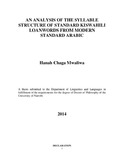An analysis of the syllable structure of standard Kiswahili loanwords from modern standard Arabic
Abstract
This thesis is an analysis of the syllable structure of Standard Kiswahili loanwords
borrowed from Modern Standard Arabic and their consequent restructuring processes.
This analysis is based on the premise that every language has specific constraints with
regard to syllable structure and segmental organization in words. Languages are bound to
borrow through contact and, as such, phonological processes are triggered in the course
of adapting and/or adopting the loanwords in the recipient language. Since Standard
Kiswahili and Modern Standard Arabic are from different language families, phonotactic
constraints of the recipient language play a role in the restructuring of these loanwords.
This thesis examines how the phonotactic constraints operate to realize the syllable
structures and segmental organization of the words borrowed from Modern Standard
Arabic to Standard Kiswahili. This being a syllable oriented research, the Generative CVPhonology
theory is applied providing a platform to display the various syllable
structures found in Modern Standard Arabic and Standard Kiswahili. Moreover, the
model enables us to note the syllable changes taking place from the Modern Standard
Arabic sourcewords to Standard Kiswahili loanwords. In addition, the theory provides
tools to examine the segments found in the loanwords and sourcewords, and how these
segments are associated to the C (consonant) and V (vowel) slots of their respective
syllables. The findings in this thesis show that the phonological processes involved in the
adaptation and adoption of loanwords from Modern Standard Arabic to Standard
Kiswahili are motivated by preferred syllable structure rules, phonemic factors,
assimilation rules and morphological factors. With regard to consonant clusters, the
phonological processes are motivated by Positive Syllable Structure Conditions and
Negative Syllable Structure Conditions of the recipient language, Standard Kiswahili.
We also observe that a bulk of the loanwords undergo adaptation processes in order to
conform to the permissible Standard Kiswahili syllable structures. However, there are a
few loanwords from Modern Standard Arabic that get adopted into Standard Kiswahili
with their original structures as motivated by Kiswahili syllable constraints, not Modern
Standard Arabic syllable constraints. That is, some of the loanwords are accommodated
in Standard Kiswahili with Modern Standard Arabic syllable structures. Finally, it is
observed that Standard Kiswahili phonology has been generally affected by loanwords
from Modern Standard Arabic through the introduction of new segments, syllable
structures, heavy syllable weights and new consonant clusters.

